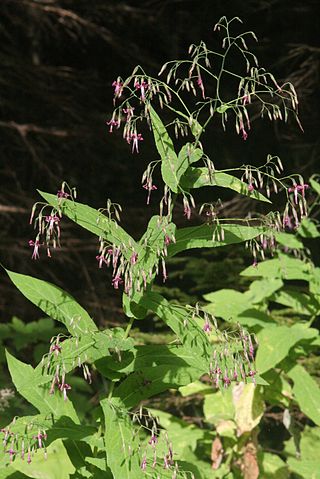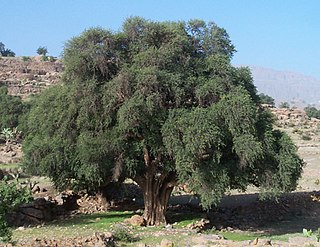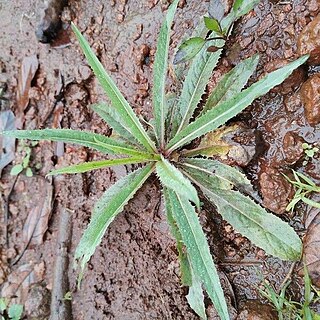
Horticulture is the cultivation of plants in gardens or greenhouses, as opposed to the field-scale production of crops characteristic of agriculture. It includes the cultivation of fruits, vegetables, nuts, seeds, herbs, sprouts, mushrooms, algae, flowers, seaweeds and non-food crops such as grass and ornamental trees and plants. It also includes plant conservation, landscape restoration, landscape and garden design, construction, and maintenance, and arboriculture, ornamental trees and lawns.

Prenanthes is a genus of plant in the family Asteraceae, often referred to as rattlesnake root.
Launaea crepoides is a species of flowering plant in the family Asteraceae. It is found only in Yemen. Its natural habitats are subtropical or tropical dry forests and subtropical or tropical dry shrubland.
Launaea rhynchocarpa is a species of flowering plant in the family Asteraceae. It is found only in Yemen. Its natural habitats are subtropical or tropical dry forests and subtropical or tropical dry shrubland.
Launaea socotrana is a species of flowering plant in the family Asteraceae. It is found only in Yemen.

The Mediterranean Acacia–Argania dry woodlands and succulent thickets is a Mediterranean forests, woodlands, and scrub ecoregion in North Africa centered mainly on Morocco but also including northwestern Western Sahara and the eastern Canary Islands.

The Cichorieae are a tribe in the plant family Asteraceae that includes 93 genera, more than 1,600 sexually reproductive species and more than 7,000 apomictic species. They are found primarily in temperate regions of the Eastern Hemisphere. Cichorieae all have milky latex and flowerheads that only contain one type of floret. The genera Gundelia and Warionia only have disk florets, while all other genera only have ligulate florets. The genera that contain most species are Taraxacum with about 1,600 apomictic species, Hieracium with about 770 sexually reproducing and 5,200 apomictic species, and Pilosella with 110 sexually reproducing and 700 apomictic species. Well-known members include lettuce, chicory, dandelion, and salsify.

Plants are the eukaryotes that form the kingdom Plantae; they are predominantly photosynthetic. This means that they obtain their energy from sunlight, using chloroplasts derived from endosymbiosis with cyanobacteria to produce sugars from carbon dioxide and water, using the green pigment chlorophyll. Exceptions are parasitic plants that have lost the genes for chlorophyll and photosynthesis, and obtain their energy from other plants or fungi.

Cucullia syrtana is a moth of the family Noctuidae first described by Paul Mabille in 1888. It is widely distributed in the desert and semi desert zone from the western Sahara and Morocco to Egypt, the Arabian Peninsula, Iraq and Iran. It has also been recorded on Malta and in Greece.
Metalopha gloriosa is a moth of the family Noctuidae first described by Otto Staudinger in 1887. It is found from western Turkey to eastern Taurus Mountains, Iraq, Anatolia, Israel, Jordan, Lebanon and Syria.

Mas huni is a typical Maldivian breakfast, comprising tuna, onion, coconut, and chili. All ingredients are finely chopped and mixed with the grated meat of the coconut. This dish is usually eaten with freshly baked roshi (flatbread) and sweetened hot tea.

Launaea sarmentosa is a perennial herb species in the family Asteraceae. It is native to coastal areas in Africa, Madagascar, the Seychelles, Mauritius, India, Sri Lanka, Maldives and Southeast Asia. It is naturalized in Western Australia.

Launaea nudicaulis, known by the common English name of bold-leaf launaea, is a species of plant which is endemic to India, as well the Negev and Judean desert. In India it is known under a common name bhatal and is found in Hazara, Mansehra, Multan, Rawalpindi and Scinde districts of Punjab and Lahore.
Amal Amin is an Egyptian botanist.
Launaea gorgadensis is a species of flowering plants of the family Asteraceae. The species is endemic to Cape Verde. It is listed as a critically endangered plant by the IUCN.

Launaea picridioides is a species of flowering plants of the family Asteraceae. The species is endemic to Cape Verde. It is listed as a vulnerable species by the IUCN.
Launaea thalassica is a species of flowering plants of the family Asteraceae. The species is endemic to Cape Verde. It is listed as critically endangered by the IUCN. The species name thalassica is Greek meaning "of the sea".

Sonchus canariensis, the tree sonchus, is a species of plant endemic to the Canary Islands.
Launaea resedifolia is a plant species in the family Asteraceae.

Helichrysum monogynum, also known as red tinderbox, is a species of flowering plant within the family Asteraceae. The species is listed as endangered due to its restricted range within 8 km² of suitable habitat and the threat of habitat degradation due to urbanisation and recreational activities.












